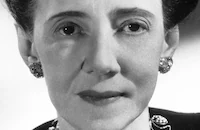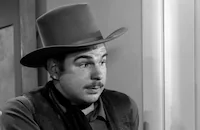Miss Tatlock's Millions
Brief Synopsis
Cast & Crew
Richard Haydn
John Lund
Wanda Hendrix
Barry Fitzgerald
Monty Woolley
Ilka Chase
Film Details
Technical Specs

Synopsis
Movie stuntman Tim Burke is approached by Denno Noonan, caretaker for wealthy Californian heir Schuyler Tatlock, who wishes to hire him to impersonate Schuyler. Noonan explains that Schuyler, a happy-go-lucky idiot and pyromaniac, accidentally burned himself to death years earlier in Hawaii, but Noonan has pretended he was still alive and living in Hawaii so that he could keep his job. Schuyler's grandparents have recently died, and Noonan needs Schuyler's presence at the reading of the will. Promised that the job will only take three-days, Burke accepts and, after dying his hair dark, joins Noonan at the Tatlock estate. Burke's resemblance to the real Schuyler is so close that even Schuyler's younger sister Nan believes her loony brother has returned from Hawaii. Schuyler's uncles and aunt, Miles, Gifford and Cassie Van Alen, bicker over who will get their father's vast millions until the will is read and they learn that he left everything to his wife, who died one hour after he did. The Tatlock's maid, Cora, then presents a letter from the deceased Mrs. Tatlock, in which she stipulated that Schuyler and Nan are to inherit the entire estate, but that Schuyler is to administer Nan's inheritance until she is twenty-one years old. Burke refuses to impersonate Schuyler for life, but Noonan begs him to stay long enough for Noonan to buy a one-way train ticket, as he fears arrest if anyone learns the truth. While Noonan is gone, Nan looks after her idiot "brother," and Burke learns that she has a crush on her cousin, Cassie's playboy son Nicky. Nicky bullies Burke, as he believes he is helpless, and Burke becomes outraged when he hears Miles, Gifford and Cassie scheming to marry Nicky to Nan so that they can control the inheritance. Acquiescing to his mother, Nicky romances innocent Nan, and when Noonan returns, Burke refuses to leave Nan alone with her avaricious family. While eavesdropping, Burke falls through the ceiling of the greenhouse when he hears Nicky propose to Nan and receives a blow to the head which knocks him out. When he revives, he speaks as himself, causing Nan to declare that her brother has been miraculously cured. Nan undertakess to re-educate Burke while he recovers from his accident, and Burke finds himself falling in love with her. Nan is confused by her own feelings of ardor for her brother, and loses interest in Nicky. When Cassie discovers Noonan and Burke's secret, she insists that Burke continue to live as Schuyler for another two years in Hawaii, until Nan comes of age, because if Schuyler is proved dead, the inheritance automatically reverts to a flower arranging society. Burke accepts the offer after Cassie agrees not to force Nicky and Nan to marry. Nan is led to believe that Burke and Noonan are leaving because Burke has had a relapse. Two years later in Hawaii, Noonan reads a description of an arsonist who sounds exactly like the real Schuyler. Realizing that Burke is truly heartsick over Nan, Noonan brings the real Schuyler, who is alive, with his Hawaiian wife and two children, back to California to reunite with his family. Noonan then brings Nan to Hawaii, where she and Burke can finally give in to their love for each other.

Director

Richard Haydn
Cast

John Lund
Wanda Hendrix

Barry Fitzgerald

Monty Woolley

Ilka Chase

Robert Stack
Dorothy Stickney

Elizabeth Patterson

Leif Erickson
Dan Tobin
Roger Davis
Clifford Brooke
Hilo Hattie

Richard Rancyd
Jerry James
Bill Neff
Howard Joslin

Matt Willis
Hugh Allen
Bill Meader
Beulah Christian

Ray Milland

Mitchell Leisen
Dick Keene
Wesley Hopper
Crew
Franz Bachelin
Guy Bennett
Charles Berner
Mahlon Boyce
Charles Brackett
Charles Brackett
Richard L. Breen
Harry Brown
Hugh Brown
Malcolm Bulloch
Doug Burke
Frank Caffey
Harry Caplan
Sam Comer
A. D. Cook
John Cope
Ed Crowder
Helen Deutsch
Everett Douglas
Ross Dowd
Hans Dreier
Pat Drew
Frank Dugas
Jimmie Dundee
Farciot Edouart
Joe Egli
Frances Goodrich
Albert Hackett
Doane Harrison
Edith Head
Ann Herbert
Harry Hogan
Gordon Jennings
Al Jermy
Richard L. Johnston
Charles B. Lang Jr.
Frank Loesser
Ronnie Lubin
Danny Mccauley
Kenneth Meade
Gene Merritt
Richard Monroe
John Robert Murphy
Harry Owens
Shirley Page
Tom Plews
Eric Selig
John Smirch
Sydney S. Street
Jule Styne
Dwight Thompson
A. Tiers
Vera Tomei
Marvin Weldon
Wally Westmore
Bill Wood
Victor Young

Film Details
Technical Specs

Articles
Robert Stack, 1919-2003
Stack was born in Los Angeles on January 13, 1919 to a well-to-do family but his parents divorced when he was a year old. At age three, he moved with his mother to Paris, where she studied singing. They returned to Los Angeles when he was seven, by then French was his native language and was not taught English until he started schooling.
Naturally athletic, Stack was still in high school when he became a national skeet-shooting champion and top-flight polo player. He soon was giving lessons on shooting to such top Hollywood luminaries as Clark Gable and Carol Lombard, and found himself on the polo field with some notable movie moguls like Darryl Zanuck and Walter Wanger.
Stack enrolled in the University of Southern California, where he took some drama courses, and was on the Polo team, but it wasn't long before some influential people in the film industry took notice of his classic good looks, and lithe physique. Soon, his Hollywood connections got him on a film set at Paramount, a screen test, and eventually, his first lead in a picture, opposite Deanna Durbin in First Love (1939). Although he was only 20, Stack's natural delivery and boyish charm made him a natural for the screen.
His range grew with some meatier parts in the next few years, especially noteworthy were his roles as the young Nazi sympathizer in Frank Borzage's chilling The Mortal Storm (1940), with James Stewart, and as the Polish flier who woos a married Carole Lombard in Ernst Lubitsch's To Be or Not to Be (1942).
After serving as a gunnery officer in the Navy during World War II, Stack returned to the screen, and found a few interesting roles over the next ten years: giving Elizabeth Taylor her first screen kiss in Robert Thorp's A Date With Judy (1948); the leading role as an American bullfighter in Budd Boetticher's The Bullfighter and the Lady (1951); and as a pilot in William Wellman's The High and the Mighty (1954), starring John Wayne. However, Stack saved his best dramatic performances for Douglas Sirk in two knockout films: as a self-destructive alcoholic in Douglas Sirk's Written on the Wind (1956), for which he received an Academy Award nomination for supporting actor; and sympathetically portraying a fallen World War I pilot ace who is forced to do barnstorming stunts for mere survival in Tarnished Angels (1958).
Despite proving his capabilities as a solid actor in these roles, front rank stardom oddly eluded Stack at this point. That all changed when Stack gave television a try. The result was the enormously popular series, The Untouchables (1959-63). This exciting crime show about the real-life Prohibition-era crime-fighter Eliot Ness and his G-men taking on the Chicago underworld was successful in its day for several reasons: its catchy theme music, florid violence (which caused quite a sensation in its day), taut narration by Walter Winchell, and of course, Stack's trademark staccato delivery and strong presence. It all proved so popular that the series ran for four years, earned an Emmy for Stack in 1960, and made him a household name.
Stack would return to television in the late '60s, with the The Name of the Game (1968-71), and a string of made-for-television movies throughout the '70s. His career perked up again when Steven Spielberg cast him in his big budget comedy 1941 (1979) as General Joe Stillwell. The film surprised many viewers as few realized Stack was willing to spoof his granite-faced stoicism, but it won him over many new fans, and his dead-pan intensity would be used to perfect comic effect the following year as Captain Rex Kramer (who can forget the sight of him beating up Hare Krishnas at the airport?) in David and Jerry Zucker's wonderful spoof of disaster flicks, Airplane! (1980).
Stack's activity would be sporadic throughout the remainder of his career, but he returned to television, as the host of enormously popular Unsolved Mysteries (1987-2002), and played himself in Lawrence Kasden's comedy-drama Mumford (1999). He is survived by his wife of 47 years, Rosemarie Bowe Stack, a former actress, and two children, Elizabeth and Charles, both of Los Angeles.
by Michael T. Toole

Robert Stack, 1919-2003
Quotes
Trivia
Notes
The working title of this film was The Tatlock Millions. This film marked actor Richard Haydn's directorial debut. Information in the Paramount Collection at the AMPAS Library reveals that supervising editor Doane Harrison was also listed as co-director on this film. Harrison was supervising editor on all of director Billy Wilder's films, for which he was frequently listed off-screen as co-director. Wilder has stated in a modern interview that while this credit should not be interpreted as equal to the director, he considered Harrison a highly esteemed collaborator. Harrison was present on the set during shooting to add his input to the concept of the scenes, and to recommend certain shots. It is likely that Harrison also contributed in this manner to Miss Tatlock's Millions.
According to information in the Paramount Collection at the AMPAS Library, the entrance to the "Tatlock" estate was filmed in San Marino, the Hawaiian beach scene was shot in Corona del Mar, and other scenes were shot in Santa Barbara, CA.














